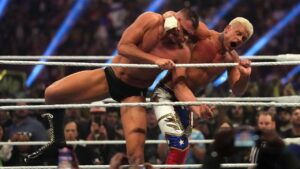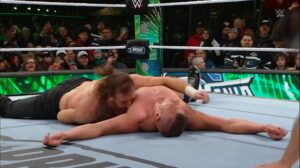In early 2005 All Japan Women’s Pro Wrestling (AJW) shut it’s doors for the last time. 15 years on and the promotion is still heralded as the greatest women’s wrestling promotion in history with a host of its top names considered to be some of the best wrestlers of all time. We’re going to go into detail here on what made AJW so special and why, to this day, its considered one of the best promotions in wrestling history.
Background
The history of AJW begins in the late 1960s with the Japan Women’s Professional Wrestling Association which aimed to get women’s promotions to work together for the good of women’s wrestling as a whole. Naturally, conflicts arose which led to Takashi Matsunaga and his siblings to set up AJW and in 1968 the company held it’s first-ever event at the Shingawa Public Hall.
Formula For Success
 Don’t get it twisted All Japan Women’s Pro Wrestling was very much an idol based promotion long before it was the 5-star match machine of the 90’s. Mach Fumiake won the WWWA Championship (AJW’s top title) at just 16 because she had success outside of wrestling as a singer/entertainer. While Fumiake’s career only lasted one-year AJW now had a formula for success and we sought to replicate this going forward with big stars like the Beauty Pair, The Crush Gals, and even Devil Masami producing music and wrestling. This formula proved to be a success as AJW had a quick boom period in the late 1970s led by the Beauty Pair’s popularity. Despite this idol focus, AJW wasn’t a bad promotion work-rate wise…
Don’t get it twisted All Japan Women’s Pro Wrestling was very much an idol based promotion long before it was the 5-star match machine of the 90’s. Mach Fumiake won the WWWA Championship (AJW’s top title) at just 16 because she had success outside of wrestling as a singer/entertainer. While Fumiake’s career only lasted one-year AJW now had a formula for success and we sought to replicate this going forward with big stars like the Beauty Pair, The Crush Gals, and even Devil Masami producing music and wrestling. This formula proved to be a success as AJW had a quick boom period in the late 1970s led by the Beauty Pair’s popularity. Despite this idol focus, AJW wasn’t a bad promotion work-rate wise…
Innovation
#ProWrestling Tomi Aoyama in the late 70's. Yes, that is a no-hands springboard crossbody. pic.twitter.com/gLOpBeyrzL
— Juan Nunez – glitch boom (@FadedEndless) October 4, 2018
Despite AJW having an emphasis on creating crossover stars, it’s wrestlers were still ahead of their time. Namely, talents like Tomi Aoyama were at least fifteen years ahead of their time. As evidenced by the gif above Aoyama was performing moves in the late 70s that would make Manami Toyota a legend in the 90s. Jumbo Hori in the early 80s was pulling off a piledriver variation that would become known as the Ganso Bomb
Jumbo Hori's Driver, which I find terrifying.
Predates that famous Ganso Bomb from one of the Kawada vs Misawa matches by a few years, too. pic.twitter.com/Z21G7uV588
— Catch Wrestling U (@CatchWrestling) May 6, 2020
This kind of innovation means that even the earliest available footage from All Japan Women’s Pro Wrestling is watchable to this day and one can only imagine how amazing it must have been to see these matches in the flesh. This coupled with the promotion’s ability to make idol stars created a perfect mix between entertaining wrestling and captivating sports entertainment.
Dump Matsumoto Changes The Game

We’ve written previously about Dump Matsumoto in detail but it cannot be understated just how much she changed the game. She introduced a showmanship that had been missing from AJW. She dyed her hair without consulting higher-ups and started to wear face paint during matches, taking this from The Great Kabuki. For AJW this sort of showmanship had never been seen before as previously heels and babyface mostly wore singlets and had very professional hairstyles. Dump Matsumoto changed all of that and created the template for what monster heel wrestlers could be going forward. Not only did Matsumoto introduce a new type of heel to AJW she was a huge success, her Gokuaku Domei stable feuded with the Crush Gals in the mid-1980s in a feud that was a ratings and box office success. The feud included main event matches in big arenas like Osaka Jo-Hall as the Crush Gals’ immense popularity led to a big boom for All Japan Women’s Pro Wrestling, even greater than the one caused by Jaguar Yokota and Devil Masami in the early 80s. Matsumoto’s influence was huge and made a lasting change to the presentation of Joshi wrestlers as she added a showmanship and flashiness that AJW had been missing. While it’s safe to say she changed the game…
Bull Nakano Changed It Further

While Dump Matsumoto redefined what it meant to be a heel her fellow stablemate and heir to the throne Bull Nakano had an even better idea. Nakano had wanted to be a babyface when she started her career but All Japan Women’s Pro Wrestling told her to be a heel and as she stated in an interview
“A new wrestler isn’t treated as “human”. I can’t say anything and I have to do what I’m told”
At the peak of her power’s Bull Nakano was the standalone ace of AJW and held the WWWA title for an AJW record of 1057 days. During this run, she put into practice her idea to move beyond the traditional constraints of babyface and heels. She decided that she would still utilize her weapons and would still wrestle like a remorseless heel, but unlike heels that came before her, she would be respectful and not cheat. Safe to say this worked as Bull Nakano became one of AJW’s biggest stars and in 1990-1992 there were very few wrestlers on her level star power-wise. It was a familiar sight for a show to end with Nakano standing tall soaking in the chants from packed venues.
Nakano leading this change was important for AJW as it allowed them to move beyond the faces/heels dynamic and instead build around stars. Names like Akira Hokuto and Aja Kong often blurred the line between good guy and bad guy but both had an aura and star power that 90% of wrestlers would kill for. This blurring of the lines was especially handy when it came to
Inter-Promotional Warfare With FMW, LLPW & JWP

For many years AJW held a monopoly on women’s wrestling in Japan. In the late 80s that changed when Japan Women’s Pro Wrestling was set up to become home to the talent that failed their test to join AJW as well as some other names like Devil Masami who AJW had forced to retire due to age. JWP became a viable promotion due to its own homegrown talent and having a big star like Masami on top. JWP would inevitably split due to differing ideologies leading to two new promotions rising from its ashes, JWP Women’s Wrestling and Ladies Legend Pro Wrestling (LLPW). The infamous Frontier Martial-Arts Wrestling (FMW) had also introduced a Joshi division which featured a mix of former AJW castoffs like Megumi Kudo and Combat Toyoda as well as it’s own homegrown talent. This meant that by 1993 there were four hubs of women’s wrestling in Japan each one with incredibly talented performers and big stars. Sensing opportunities these promotions began working together to bring about cross-promotional dream matches and historic supercards of women’s wrestling like Dream Slam 1993 or Big Egg Universe in 1995 as well as other events like LLPW’s first-anniversary show that featured a full card of AJW vs LLPW matches.
To many, this was the pinnacle of professional wrestling as fans packed arenas regularly to see cross-promotional dream matches like the JWP vs AJW Thunder Queen Battle, the Shinobu Kandori (LLPW) vs Akira Hokuto (AJW) series, many top tier tag matches like Dynamite Kansai & Mayumi Ozaki (JWP) vs Manami Toyota & Toshiyo Yamada (AJW) series. This all culminated in 1995 for Big Egg Universe which was a cross-promotional event that took place at the Tokyo Dome and featured a tournament made up of the top names from each Joshi promotion as well as a WWF Women’s Championship match.
Jaguar Yokota’s Students
In the early 80s Jaguar Yokota was a big star for AJW and was practically unbeatable as the ace of the promotion. Following her retirement, she became a trainer for AJW and her influence is immeasurable. All Japan Women’s Pro Wrestling is known now as a workrate powerhouse and it was Yokota’s students like Toyota, Yoshida, Kyoko Inoue, and others that were leading this charge. Toyota alone has thirteen 5-star matches according to Dave Meltzer and has 21 matches rated at 8.0 or over on Cagematch, despite not being as highly regarded by the general fanbase Kyoko Inoue has seven 5-star matches.
So… With All That Said, Why Did AJW Die?
So far we have talked about AJW as a promotion that could do no wrong. From innovation to reinvention to holding a huge event in the Tokyo Dome it was a powerhouse of Japanese women’s wrestling. So why did it die off? There isn’t one particular reason, there are a few that piled up leading to the promotion’s demise.
Matsunaga Family
The first, and biggest reason was the ownership went bankrupt. The Matsunaga families investments outside the world of wrestling didn’t turn out too well due to a financial crisis in 1997 that came not long after a similar issue in the late 80s/early 90s where an asset pricing bubble burst. This led to the Matsunaga family owing big amounts of debt that led to them being unable to pay the salaries of some AJW performers. At the time AJW was running an insane schedule of shows it would be impossible for these performers to earn money in other ways so the companies inability to pay was troubling. This came to a breaking point in the summer of 1997 when they lost fourteen wrestlers including top stars like Kong, Inoue, Yoshida, Etsuko Mita, Mima Shimoda, among others. Some of these women went on to start their own promotions which leads us to the next issue.
Competition
GAEA JAPANの旗揚げ戦を観戦した時の衝撃は今でも忘れられない‼︎
新人のあの太ももの太さからガムシャラさスピード感そしてあの目の輝き、獲物を捕らえるようなあの目つき、声、勝った時、負けた時の表情。どれもこれも衝撃的だったのを覚えています‼︎
『やられたら やり返す』#gaea一夜復活 pic.twitter.com/Lg942bxXa5— chigudonbocchi (@chigudonbochib1) March 5, 2020
All Japan Women’s Pro Wrestling had created a big market for Joshi and by the late 1990s the market was crowded with a number of companies for fans and performers to choose from. During previous dips in business, AJW had time to recover and create new stars but following the exodus of 1997, there was just too much competition with JWP and LLPW still going strong as well as newcomers to the market like ARISON, GAEA Japan and others. In addition, had AJW fallen on tough financial times at any other point in history their talent, unfortunately, would’ve had two options. Deal with the low (or no) pay, or retire. But with a wealth of companies to perform for talents had more bargaining power and were able to leave when the company fell on financial difficulties.
Mandatory Retirement At Age 25
The final issue that we have identified is the mandatory retirement at 25 rules. While the intentions of this rule were somewhat good, retirement at this age would allow performers time to build a career and life post-wrestling, it also turned out to be a reason for their downfall as they forced huge stars like Devil Masami and Chigusa Nagayo to retire but both would come back for other promotions and lead them to Stardom, Nagayo and Crush Gals partner Lioness Asuka especially was such a cultural icons that forcing them to retire seems insane in hindsight. On the other hand getting rid of the rule played into their downfall in some ways too. Had the rule not been abolished in the early 90s then by the time their financial issues struck in 1997 names like Aja Kong would’ve been gone and new, presumably cheaper, stars would have already replaced her. AJW bloating their roster and relying on a small group for as long as they did while not really focusing on building new stars came back to bite them eventually.
Despite the issues in 1997 the company lived on until 2005 but lost its TV Deal in 2002 which was the final nail in the coffin. It’s been fifteen years since the promotion’s closure yet the impact of All Japan Women’s Pro Wrestling is still felt today. This promotions represents the pinnacle of women’s wrestling globally and is considered by many to still be one of the greatest promotions of all time for their longevity, ability to build stars, and the quality of matches they put out many of which hold up all these years later despite all the changes wrestling has gone through.






